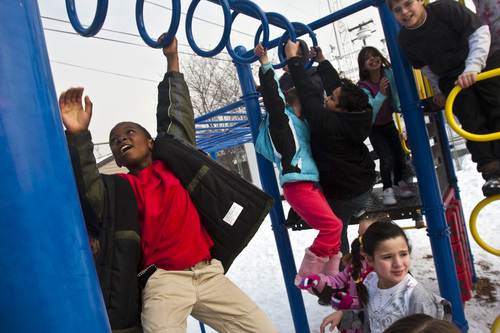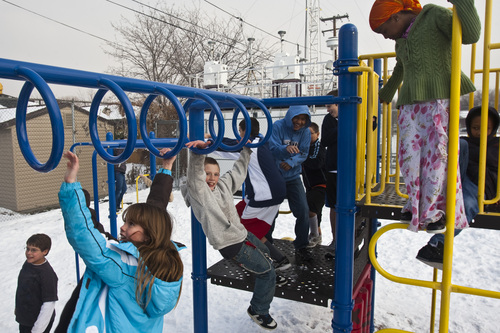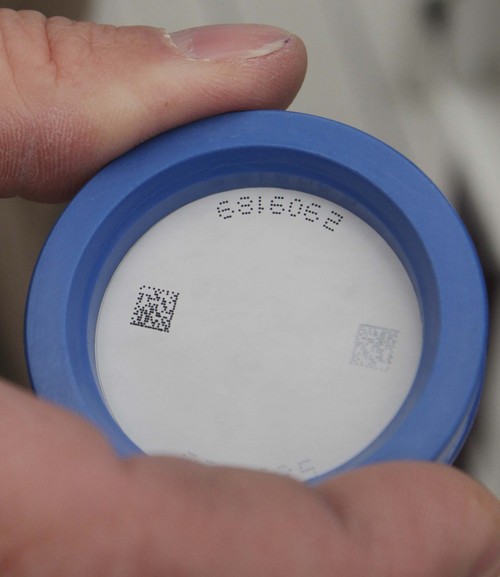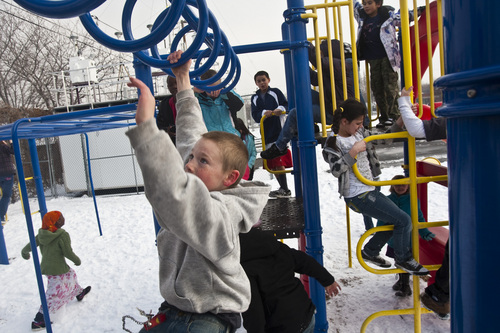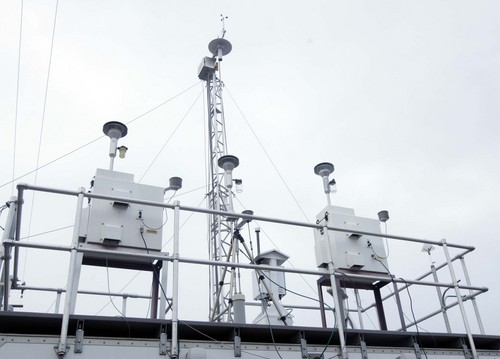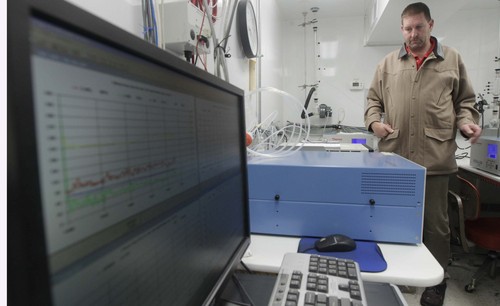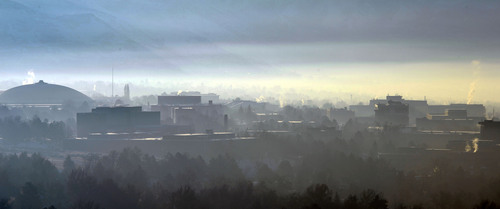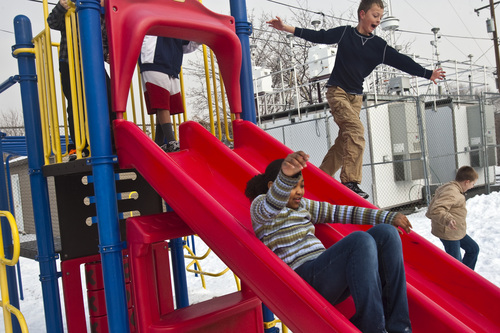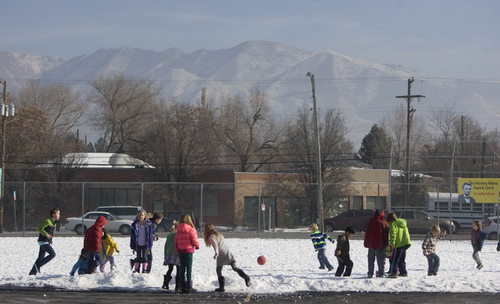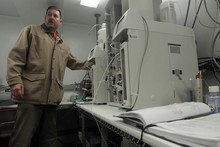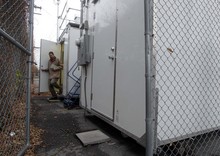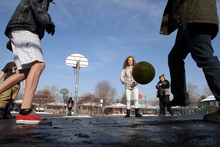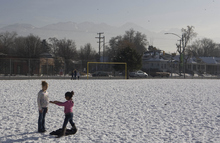This is an archived article that was published on sltrib.com in 2013, and information in the article may be outdated. It is provided only for personal research purposes and may not be reprinted.
The machinery at the edge of the playground never stops humming. Equipment in and on top of two trailers at Salt Lake City's Hawthorne Elementary School constantly draws air through filters and sensors, recording levels of several unhealthy pollutants.
Other instruments measure wind, temperature, humidity and visibility. Some record a continuous flow of data, while others take snapshots lasting an hour or a day.
This station is a critical nerve center in Utah's air quality monitoring network that sheds light on our wintertime nightmare, the soup of fine particulate matter, or PM2.5, that pools in urban valley bowls.
"One trailer holds research equipment that is trying to answer the questions why do we have air pollution and what can we do to eliminate it," said Bo Call, who supervises the Utah Division of Air Quality's 26-station monitoring program. "The stuff in the other trailer is monitoring what current pollution levels are."
Why do we have such dirty air and what can we do about it? These seemingly simple matters have proven to be stubbornly complicated and defy simple solutions.
PM2.5 is a catchall category of pollutants, defined as particles and droplets less than 2.5 microns in diameter. The threat to your health lies with the particles' size — 1/20th the width of a human hair — so tiny they lodge deep in lung tissue and are linked to many diseases, from cancer to asthma and even autism.
The DAQ posts hourly updates on PM2.5 levels recorded at various monitoring stations, along with trends and forecasts.
Some doctors advise pregnant patients to clear out of the Salt Lake Valley during the region's notorious inversions, when high pressure systems trap polluted air near the valley floors. The situation is worse when snow covers the ground because the white blanket deflects the sun's radiant heat, which would otherwise promote atmospheric mixing.
"I commute by bike every day that I can. The problem is when air quality is bad I have to drive and that's backwards," said Carleton DeTar, who lives in the Salt Lake City's Avenues neighborhood and works at the University of Utah.
"We have to do a lot more [to address air pollution] than people elsewhere because of our topography and weather," he said. "It's a topography we love because we like to ski and hike in the mountains."
—
'We want to understand' • Despite air pollution's impact on public health, quality of life and economic growth, Utah regulators and scientists have yet to gain a firm grasp on where particulate pollution comes from, what chemicals make it up, how it behaves and, most importantly, how to reduce it.
The state did not even begin monitoring PM2.5, as a distinct subset of the much larger particles known as PM10, until 2000, a few years after the U.S. Environmental Protection Agency (EPA) set thresholds on fine particulate.
Tailpipes, smoke stacks and wood stoves inject particulate straight into air. But most of the PM2.5 contributing to our pollution crisis is emitted in the form of "precursor" gases, such as nitrous oxides and volatile organic compounds (VOC), which react in the atmosphere to form particles.
Inversions, by concentrating these gasses, also abet the reactions that create particulate, making the problem even worse.
Conventional wisdom says more than half the fine particulate comes from vehicle exhaust. That's according to the state's "emissions inventories," estimates of how much PM2.5 and its precursors are emitted by various sources.
But most of the PM2.5 in the air is not emitted — it's created by the interaction of the precursor chemicals. And it's unclear which precursors from what sources are the most responsible.
This question of "source apportionment" is the subject of research underway at Brigham Young University and the University of Utah. One recent U. study concluded wood smoke accounts for a far bigger share of the problem than previously believed.
Kerry Kelly, a U. chemical engineering researcher, analyzed particles gathered over four winters at the Hawthorne station, as well as stations at Lindon and Bountiful. Chemical signatures indicate that as much as 38 percent of the particulate gathered during high-pollution days came from wood smoke.
"Compared with burning natural gas or gasoline, burning wood produces orders of magnitude more VOC, hundreds of thousands more VOC per unit of energy output," said Kelly, who serves on the Utah Air Quality Board.
Her findings spurred calls from public health advocates to phase out wood stoves, but officials say such measures could be premature. Kelly's current research seeks to distinguish wood-smoke pollution from heating stoves versus charcoal-fired grills.
"We want to invest money where we have the most benefit. We want to understand the problem so we propose the correct solutions," Kelly said.
For the first time, Gov. Gary Herbert intends to invest state money in research as part of a proposed $18 million package of new spending next year targeting air quality.
The $1 million the governor wants to divert to science is equivalent to what California spends each day on air quality research. But it's a start and allows the state a say in how academic research, usually funded with federal money, is structured.
—
Making choices • It may be of little solace to DeTar and other Wasatch Front residents who suffered the hazards of this month's ugly and stubborn inversion, nor to the 78 percent of respondents in a recent Envision Utah survey who said they believe air quality has worsened over the past two decades.
But particulate pollution has declined here since the state began monitoring it in the late 1980s, according to Jaron Hansen, a BYU chemistry professor.
He attributes the gains to widespread use of catalytic converters in cars and big reductions of sulphur dioxide from industrial emissions, thanks to new processes and smokestack scrubbers.
Still, the air over Salt Lake, Cache and Utah valleys exceeds federal standards for ambient levels of fine particulate, set at 35.5 micrograms per cubic meter of air, far too often. The EPA has declared these three Utah airsheds out of "attainment" of the PM2.5 standard and the state is implementing plans to reduce emissions of particulates and their precursors.
During winter inversions, Hawthorne principal Marian Broadhead constantly monitors the fine particulate readings that DAQ updates hourly based on data coming from her own playground.
When concentrations exceed 55 micrograms, she is faced with two bad choices: Usher kids outside for recess, thus exposing their growing lungs and brains to pollution, or keep them inside. Losing outdoor recess bothers Broadhead because research shows physical exercise benefits developing minds.
"It's tricky. In the mornings, it can be cold [less than 10 degrees] but the air quality can be good. In the afternoon it can be 25 or 30 degrees but the air quality gets bad," Broadhead said. "Students need the opportunity for movement and academically they need that break."
Like Broadhead, many school administrators allow kids with asthma and other sensitive conditions to stay inside for recess when pollution reaches the 35.5 microgram threshold, and those with colds are advised to remain inside at 55 micrograms.
At 90 micrograms all students should stay inside for recess, according to state health guidelines.
—
'It all starts with NOx' • Nitrous oxides, or NOx, released whenever fossils fuels are burned, are a major precursor. Hansen said much of our fine particulate pollution starts as nitrogen dioxide, which reacts with the hydroxyl radicals that are common in our atmosphere, to form nitric acid.
Ammonia also abounds here and when it reacts with nitric acid, the result is ammonium nitrate, a compound that accounts for most of the secondary PM2.5 pollution, according to Hansen. This compound draws in water and other molecules to form the particles that make up much of the air pollution problem.
"With Hawthorne data we tried to find the limiting factor [for particulate formation]. Nitric acid is that factor," Hansen said. "It all starts with NOx. If you cut the amount of cars on the road, you cut the amount of nitric acid that forms."
Hansen is now loading a trailer with sophisticated monitoring equipment that his team, which includes BYU economist Arden Pope, will drive around the Wasatch Front this winter, gathering new data from various locations. This intensive monitoring is aimed at figuring out the various emission sources' role in the particulate stew.
The state's fixed monitoring stations are also gathering data and samples that scientists hope to use to trace pollution back to its source and predict what would happen if those sources reduce what they spew.
At Hawthorne, one device captures 24 hours worth of fine particulate on small Teflon disks, which are collected every week or so and sent to a lab for analysis. But since so much of the PM2.5 forms in the atmosphere, it is difficult to link a particular particle to a particular source.
The stations that monitor a broad array of pollutants, including ozone, carbon monoxide and NOx, tend to be located in school yards not because they are more polluted, but because they occupy urban spaces that are wide open.
"They can't be next to trees," which disrupt wind patterns and respire their own gases, Call said, standing on top of the Hawthorne station.
"Three years ago we had to move all this stuff over 20 feet because that tree over there was too close to our inlet," he said. "We have six feet to spare so hopefully that tree doesn't grow too much more."
Share the story of your bad air day
For some Utahns, inversion season is simply annoying. It means fewer outdoor exercise days, eye-and-throat irritation and a less-than-picturesque view. For others, though, the cloud of pollution that clings to the valley floor is a serious threat that exacerbates existing health problems and makes Salt Lake City virtually unlivable in the winter months.
How does poor air quality affect you? The Salt Lake Tribune and KUED Channel 7 want to hear your bad air day stories — whether written or video-recorded.
Send written stories to utairquality@sltrib.com or outreach@kued.org with "My Bad Air Day" in the subject line, or share them at https://www.facebook.com/saltlaketribune or https://www.facebook.com/kuedchannel7.
You also may share video stories on Tout at http://www.tout.com/sltrib or by using the hashtag #mybadairday on Instagram.
The Tribune and KUED will share your stories as part of our ongoing air quality coverage. —
About this series
This is the first in an occasional series of stories examining Utah's air quality through the monitoring station collecting data at Hawthorne Elementary School, at 1675 South 600 East Salt Lake City, and the surrounding community.
The air at Hawthorne Elementary is much the same as the rest of Utah's urban valleys — but the school is the focus of some of the most crucial research in the state.


